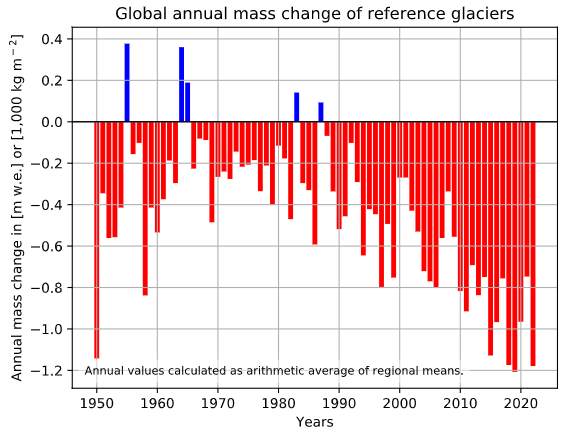Mountain glaciers around the world have been rapidly melting due to rising global temperatures. This phenomenon not only affects the natural landscape, but also has far-reaching impacts on local communities and the global climate. Understanding the causes and effects of mountain glacier melt is crucial for addressing the effects of climate change.
Glaciers are formed when snow accumulates over time and turns into ice. As temperatures rise, the ice melts and retreats. Over the past century, global temperatures have risen significantly due to human activities, such as the burning of fossil fuels and deforestation, which release greenhouse gases into the atmosphere. These gases trap heat and cause the planet to warm, leading to the melting of glaciers and other forms of ice.

Figure 1: Photos documenting the disintegration of Italy’s Careser Glacier between 1933 (top) and 2012 (bottom). After decades of negative mass balance, glaciers worldwide are shrinking, fragmenting, or disappearing. Photos courtesy of Luca Carturan, University of Padova
Glaciologists figure out how healthy a glacier is by looking at its annual mass balance. This is the difference between how much snow falls (mass gain) and how much melts (mass loss) in a given year. The mass balance shows how the weather is over a (hydrological) year, and if it is measured over a long time and shown in a cumulative way, it can show how the climate is changing. Seasonal melt adds to runoff, and the annual balance (the net change in glacier mass) adds to changes in sea level.

Figure 2: Annual mass balance of reference glaciers with more than 30 years of ongoing glaciological measurements. Annual mass change values are given on the y-axis in the unit meter water equivalent (m w.e.) which corresponds to tonnes per square meter (1,000 kg m-2). Source: WGMS (2021, updated and earlier reports).
Mountain glaciers play a critical role in providing freshwater to local communities and maintaining the Earth's water cycle. As glaciers melt, they contribute to rising sea levels, which can lead to flooding, erosion, and other coastal hazards. In addition, the loss of glaciers can also cause changes in the timing and volume of freshwater runoff, affecting the availability of water for drinking, irrigation, and hydropower. Furthermore, mountain glaciers serve as important indicators of climate change. Their rapid melting is a clear sign of the warming of the Earth and provides a tangible example of the effects of climate change.

Figure 3: Cumulative mass change relative to 1976 for regional and global means based on data from reference glaciers. Cumulative values are given on the y-axis in the unit meter water equivalent (m w.e.) Source: WGMS (2021, updated and earlier reports).
The mass balance estimates here are based on a set of global reference glaciers with more than 30 years of continued observations for the time-period. These are collected by the World Glacier Monitoring Service (WGMS) in annual calls-for-data from a scientific collaboration network in more than 40 countries around the world. Arithmetic averages are used to figure out the values for each region. To avoid giving more weight to well-observed regions, global values are calculated by taking the average of only one value for each region with glaciers. Due to the small sample size, values before 1960 and in 2021 and 2022 should be taken with care.
Keep in mind that the specific mass balance of the reference glaciers is a measure of the state of glaciers around the world. But these glaciological field observations and geodetic satellite measurements must be used together to figure out how the mass of glaciers around the world is changing and how that affects sea level rise.
To slow down the melting of mountain glaciers and address the effects of climate change, it is essential that we reduce our greenhouse gas emissions. This can be achieved through a combination of individual actions, such as reducing energy use and driving less, and collective action, such as implementing policies to transition to renewable energy sources and protect forests. In addition, it is important to support research and monitoring of mountain glaciers to better understand their behavior and the effects of climate change. This information can be used to inform the development of effective strategies for mitigating the impacts of glacier melt and adapting to the changes that are already underway.
Mountain glacier melt is a major impact of the changing climate and has far-reaching effects on both local communities and the global climate. By reducing greenhouse gas emissions and supporting research and monitoring, we can work to slow down the melting of glaciers and address the effects of climate change.
Major Data Sources:
Link: https://wgms.ch/latest-glacier-mass-balance-data/
References:
WGMS (2021, updated, and earlier reports). Global Glacier Change Bulletin No. 4 (2018-2019). Zemp, M., Nussbaumer, S. U., Gärtner-Roer, I., Bannwart, J., Paul, F., and Hoelzle, M. (eds.), ISC(WDS)/IUGG(IACS)/UNEP/UNESCO/WMO, World Glacier Monitoring Service, Zurich, Switzerland, 278 pp., publication based on database version: doi:10.5904/wgms-fog-2021-05.
This website was produced with the support of the United States Agency for International Development (USAID) under the terms of USAID's Research for Decision Makers (RDM) Activity cooperative agreement no. AID-388-A-17-00006
Views expressed herein do not necessarily reflect the views of the U.S. Government or USAID. icddr,b is also grateful to the Governments of Bangladesh, Canada, Sweden and the UK for providing unrestricted/institutional support
68, Shaheed Tajuddin Ahmed Sarani Mohakhali, Dhaka 1212, Bangladesh
icddr,b is located at the Mohakhali area in Dhaka, just ask your driver for the "Cholera Hospital"
